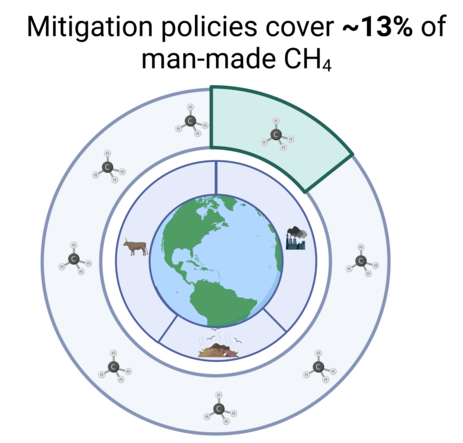According to recent research from Queen Mary University of London, just about 13% of worldwide methane emissions are regulated, despite the fact that methane emissions cause at least 25% of current global warming.

Global review of methane policies. Image Credit: Queen Mary University of London
The global review, published on May 19th, 2023, in One Earth, also discovered that little is known about the effectiveness of existing policies, with potentially unrepresentative methane emission estimates being used instead of real measurements. Inaccurate estimates can also lead to decision-makers taking the situation less seriously.
The researchers believe that to fulfill the global climate targets, the absence of regulation and understanding of their impact should be addressed as soon as possible. According to the review, a unified global strategy with accurate quantification and reporting could open up new chances to dramatically cut global warming levels.
To fulfill the Paris Agreement’s 1.5 °C target, man-made methane emissions should be cut by 40–45% by 2030 compared to 2020 levels. Methane mitigation is not just a low-cost technique for reducing global warming, but it may also improve air quality. Methane emissions have been increasing each year since the 1980s.
This global review of methane regulations is the first to examine all major man-made emission sources, including agriculture, energy, and waste. Researchers examined the geographical coverage, strength, and effectiveness of 281 policies globally, 255 of which are currently on track, with the goal of monitoring and reducing methane emissions.
Around 90% of recognized national policies have been implemented in three regions: North America (39%), Europe (30%), and Asia Pacific (21%). Globally, the finding shows that methane policies have gradually increased since 1974. However, fossil methane policies, such as those targeting emissions from the coal, oil, and gas sectors, are less rigorous than those targeting biogenic methane sources, particularly in the waste sector.
Additional mitigation potential in jurisdictions with fossil methane regulations includes emissions further along the supply chain, such as emissions from LNG carrier ships, which were explored by a team of QMUL researchers headed by Dr. Balcombe.
One of the most difficult aspects of detecting methane emissions is correctly identifying and quantifying sources. Developing and deploying technologies to monitor methane emissions, like satellites, can assist policymakers with the measurement, verification, compliance, and detection of super-emitters.
Implementing policies with broader policy coverage, mitigation solutions, including major sources, and measurable objectives could result in considerable reductions in methane emissions.
Methane reduction is still perceived as a choice rather than a necessary step alongside CO2 reduction to combat global warming. And with so many different sources, there needs to be stronger social support and the political will to act.
Maria Olczak, Lead Researcher, Queen Mary University of London
Maria Olczak adds, “Our review highlights the value of setting policies that are predictable and clear for the industry. They will aid effective investment decisions aligned with the long-term climate mitigation goals, including the decrease in emission intensity and in production across developed and developing economies.”
It’s shocking to see that most methane emissions aren’t regulated when they contribute heavily to global warming today, although accurately monitoring emissions is not easy. Our chances of reaching global climate targets are slim if this goes unchecked. The good news is that there’s an enormous opportunity to limit warming in the short term if we act fast to get on top of methane emissions. We urgently need tighter regulation on better monitoring of methane and concrete actions towards reduction measures.
Dr. Paul Balcombe, Study Author and Senior Lecturer, Chemical Engineering, Queen Mary University of London
“Over the last few years, we have seen growing attention to methane thanks to multilateral initiatives such as the International Methane Emissions Observatory and the Global Methane Pledge. The European Union and the US EPA are now working to finalize ambitious regulations targeting methane emissions in the energy sector,” states Andris Piebalgs, study author and part-time Professor at the Florence School of Regulation and a former EU Commissioner for Energy.
Andris Piebalgs concludes, “I hope that the upcoming COP28 and the first Global Stocktake will make the policymakers across the world realize that methane mitigation is an effective way to enhance their climate commitments.”
Journal Reference
Olczak, M., et al. (2023). A global review of methane policies reveals that only 13% of emissions are covered with unclear effectiveness. One Earth. doi.org/10.1016/j.oneear.2023.04.009.
Source: https://www.qmul.ac.uk